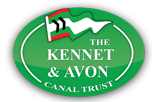

Powered by Camelot Media Ltd



-------------------------------------------------------------------------------------------------------------------
Page Two
Building the Canal - Canal Technology
Methods
The methods and equipment used to construct canals in 1794 were relatively basic, and although steam powered equipment could sometimes be used, in the main picks and shovels were used for digging and wooden wheelbarrows for moving earth and rocks.
Clay lined the channel to make it watertight, and brick and stone was used to build structures such as bridges and locks.
Timber was the material for creating lock gates and swing bridges, and both cast and wrought iron for constructing pumps, ornamental bridges and various other metal components that were used in the construction process.
At this period metallurgy was still in its infancy and the production of steel was as yet not possible
Innovation
It was however a period of rapid change and innovation, and canal engineers were at the forefront of this.
Where this was concerned, John Rennie for example, is credited with being the first man to use cast iron ball races to enable swing bridges to pivot more easily.
Steam-powered pump
Steam operated beam engines were utilised for powering pumps and two engines of this type were installed at Crofton, near Great Bedwyn, Wiltshire.
A reservoir had been created at Wilton Water by damming a number of small streams, and the Crofton pumps took water from there and pumped it to the summit pound.
A good supply of water was necessary at the summit point of all canals so that an initial water supply was available in both directions.
Water-powered pump
Another form of pump, this time powered by a water wheel operating in the River Avon, was used at Claverton to pump water from the river to the nine-mile pound heading east between Bath and Bradford on Avon
Locks
Changes in level on the Kennet and Avon were achieved by the use of pound locks.
These consist of a chamber on the line of the canal which is closed at each end by mitred gates and has a facility for filling and emptying the chamber by means of sluices (paddles).
Boats that enter this chamber are thus raised or lowered as water is let in or drained out of the chamber.
Where steam or other mechanical arrangements could not be utilised, and in particular for hauling boats and barges, the horse was the motive power.
The 'navvies'
The canal company and its contractors also employed labourers who were known as navigators or navvies (hence the term in use today).
These men were usually agricultural labourers who found canal building work more financially rewarding than that associated with farming.
During the boom years some workers would follow the canal contracts, providing a ready pool of labour for the company to use.
Contemporary newspaper reports of court proceedings at places such as Bath, Devizes, Salisbury and Newbury, suggest that drunkenness and rowdiness amongst the navvies was a common occurrence, and one which caused much concern within the rural canal side communities.
Poor Administration
The administrative organisation established to control canal building was far from ideal.
In particular the financial responsibility delegated to district committees was unfortunately accompanied by a lack of inspection of completed work.
This invariably resulted in work having to be redone, and corrupt practices such as payment for uncompleted work, false completion statements, and even payment for work that had never been started, created many problems.
The perpetrators did not however always get away with their offences and in 1798 for example the canal company prosecuted James Hollingworth of Seend, Wiltshire, who had been paid £2,397 for £1,668 worth of work.
Unable to account for the discrepancy, and unable to make repayment he was sent to prison for the debt.
These problems aside, the canal building gradually progressed mile by mile and lock by lock, and the completion of each section opened up yet another length of waterway for trade and communication.
Building the Canal - The Engineers
Need for new skills
During this period canal building was in its infancy, and although the engineers involved had experience in designing and building water wheel powered mills, the technical requirements of canal building was such that they had to develop new skills, equipment, and approaches.
These included surveying methods and skills, as well as map making, which was largely learnt from military engineers who, up to the late 18th century, were the only professionals involved in such work.
Water management
Canal engineers also had to develop new ways of water management, often involving the building of pound locks, creating new or diverting existing watercourses, and pumping water to where it was required.
These men were innovators developing new solutions to hitherto unknown problems such as building skew bridges at an angle across the canal.
Problem definition and associated solutions were initially empirical in nature, but later better-educated engineers such as John Rennie were able to use more analytical approaches.
Building the Canal - The Builders
Building committees
The building of the Kennet and Avon Canal was initially the responsibility of three district committees; the Western District, the Wiltshire District and the Eastern District.
In 1802 the Wiltshire District was subsumed into the Western District.
These committees had delegated financial responsibility and awarded contracts for construction and other associated work.
Most of this work was awarded to local businesses and, in addition to constructing the canal itself, these businesses were contracted to build associated roads, bridges, workshops, and houses.
Demand for stone
During this period the requirement for stone became so great, that the canal company opened its own quarries near Bath.
Stonemasons
Local men were employed in the quarries and as stonemasons. Careful examination of bridges and other structures on the canal reveal what are known as 'masons marks'.
These marks were carved by individual stonemasons and, have the appearance of Egyptian hieroglyphics.
In practice the marks were used to show supervisors which mason was responsible for a particular run of work over a known period.
This arrangement provided an early form of quality control, as well as allowing piecework assessments to be made prior to payment.
Building the Canal - Canal Technology
Methods
The methods and equipment used to construct canals in 1794 were relatively basic, and although steam powered equipment could sometimes be used, in the main picks and shovels were used for digging and wooden wheelbarrows for moving earth and rocks.
Clay lined the channel to make it watertight, and brick and stone was used to build structures such as bridges and locks.
Timber was the material for creating lock gates and swing bridges, and both cast and wrought iron for constructing pumps, ornamental bridges and various other metal components that were used in the construction process.
At this period metallurgy was still in its infancy and the production of steel was as yet not possible
Innovation
It was however a period of rapid change and innovation, and canal engineers were at the forefront of this.
Where this was concerned, John Rennie for example, is credited with being the first man to use cast iron ball races to enable swing bridges to pivot more easily.
Steam-powered pump
Steam operated beam engines were utilised for powering pumps and two engines of this type were installed at Crofton, near Great Bedwyn, Wiltshire.
A reservoir had been created at Wilton Water by damming a number of small streams, and the Crofton pumps took water from there and pumped it to the summit pound.
A good supply of water was necessary at the summit point of all canals so that an initial water supply was available in both directions.
Water-powered pump
Another form of pump, this time powered by a water wheel operating in the River Avon, was used at Claverton to pump water from the river to the nine-mile pound heading east between Bath and Bradford on Avon
Locks
Changes in level on the Kennet and Avon were achieved by the use of pound locks.
These consist of a chamber on the line of the canal which is closed at each end by mitred gates and has a facility for filling and emptying the chamber by means of sluices (paddles).
Boats that enter this chamber are thus raised or lowered as water is let in or drained out of the chamber.
Where steam or other mechanical arrangements could not be utilised, and in particular for hauling boats and barges, the horse was the motive power.
The 'navvies'
The canal company and its contractors also employed labourers who were known as navigators or navvies (hence the term in use today).
These men were usually agricultural labourers who found canal building work more financially rewarding than that associated with farming.
During the boom years some workers would follow the canal contracts, providing a ready pool of labour for the company to use.
Contemporary newspaper reports of court proceedings at places such as Bath, Devizes, Salisbury and Newbury, suggest that drunkenness and rowdiness amongst the navvies was a common occurrence, and one which caused much concern within the rural canal side communities.
Poor Administration
The administrative organisation established to control canal building was far from ideal.
In particular the financial responsibility delegated to district committees was unfortunately accompanied by a lack of inspection of completed work.
This invariably resulted in work having to be redone, and corrupt practices such as payment for uncompleted work, false completion statements, and even payment for work that had never been started, created many problems.
The perpetrators did not however always get away with their offences and in 1798 for example the canal company prosecuted James Hollingworth of Seend, Wiltshire, who had been paid £2,397 for £1,668 worth of work.
Unable to account for the discrepancy, and unable to make repayment he was sent to prison for the debt.
These problems aside, the canal building gradually progressed mile by mile and lock by lock, and the completion of each section opened up yet another length of waterway for trade and communication.
Building the Canal - The Engineers
Need for new skills
During this period canal building was in its infancy, and although the engineers involved had experience in designing and building water wheel powered mills, the technical requirements of canal building was such that they had to develop new skills, equipment, and approaches.
These included surveying methods and skills, as well as map making, which was largely learnt from military engineers who, up to the late 18th century, were the only professionals involved in such work.
Water management
Canal engineers also had to develop new ways of water management, often involving the building of pound locks, creating new or diverting existing watercourses, and pumping water to where it was required.
These men were innovators developing new solutions to hitherto unknown problems such as building skew bridges at an angle across the canal.
Problem definition and associated solutions were initially empirical in nature, but later better-educated engineers such as John Rennie were able to use more analytical approaches.
Building the Canal - The Builders
Building committees
The building of the Kennet and Avon Canal was initially the responsibility of three district committees; the Western District, the Wiltshire District and the Eastern District.
In 1802 the Wiltshire District was subsumed into the Western District.
These committees had delegated financial responsibility and awarded contracts for construction and other associated work.
Most of this work was awarded to local businesses and, in addition to constructing the canal itself, these businesses were contracted to build associated roads, bridges, workshops, and houses.
Demand for stone
During this period the requirement for stone became so great, that the canal company opened its own quarries near Bath.
Stonemasons
Local men were employed in the quarries and as stonemasons. Careful examination of bridges and other structures on the canal reveal what are known as 'masons marks'.
These marks were carved by individual stonemasons and, have the appearance of Egyptian hieroglyphics.
In practice the marks were used to show supervisors which mason was responsible for a particular run of work over a known period.
This arrangement provided an early form of quality control, as well as allowing piecework assessments to be made prior to payment.
Canal building tools (Kennet and Avon Canal Museum collection)
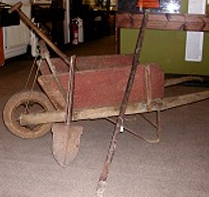
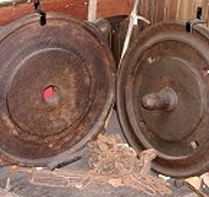
Ball race used on swing bridges (Kennet and Avon Canal Museum collection)
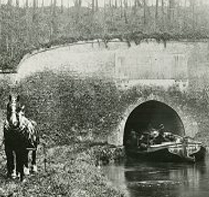
Horses and 'Unity' at Bruce Tunnel near Marlborough
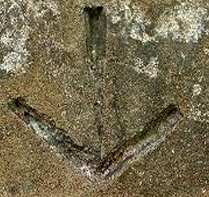
Stonemason's mark on bridge at Sydney gardens, Bath
Copyright the Kennet & Avon Trade Association MMXII

|
|
|
|
|
|
|
|
|
|
Sponsored by the Kennet & Avon Trade Association
